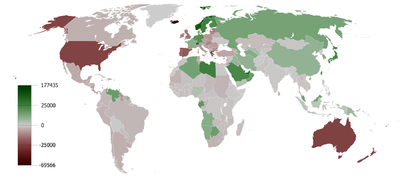
Back ميزان تجاري Arabic Ticarət balansı AZ Търговски баланс Bulgarian বাণিজ্য ভারসাম্য Bengali/Bangla Balança comercial Catalan Obchodní bilance Czech Handelsbalance Danish Handelsbilanz German Komerca bilanco EO Balanza comercial Spanish


Balance of trade can be measured in terms of commercial balance, or net exports. Balance of trade is the difference between the monetary value of a nation's exports and imports over a certain time period.[1] Sometimes a distinction is made between a balance of trade for goods versus one for services. The balance of trade measures a flow variable of exports and imports over a given period of time. The notion of the balance of trade does not mean that exports and imports are "in balance" with each other.
If a country exports a greater value than it imports, it has a trade surplus or positive trade balance, and conversely, if a country imports a greater value than it exports, it has a trade deficit or negative trade balance. As of 2016, about 60 out of 200 countries have a trade surplus. The notion that bilateral trade deficits are bad in and of themselves is overwhelmingly rejected by trade experts and economists.[2][3][4][5]
- ^ O'Sullivan, Arthur; Sheffrin, Steven M. (2003). Economics: Principles in Action. Upper Saddle River, New Jersey: Pearson Prentice Hall. p. 462. ISBN 0130630853.
- ^ Cite error: The named reference
:15was invoked but never defined (see the help page). - ^ Cite error: The named reference
:0was invoked but never defined (see the help page). - ^ Cite error: The named reference
:1was invoked but never defined (see the help page). - ^ "What Is the Trade Deficit?". The New York Times. 9 June 2018. ISSN 0362-4331. Retrieved 10 June 2018.